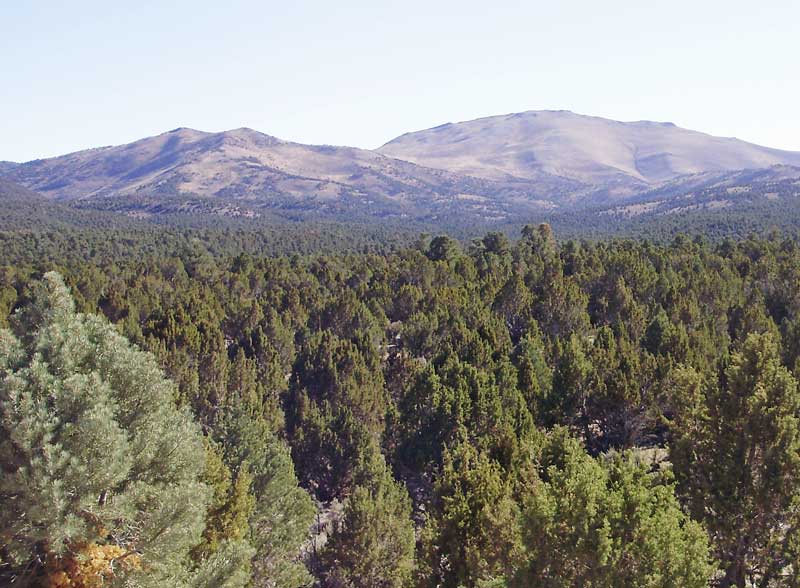author: Kevin Curran
updated: 2-7-2020
Southern California is home to a diverse collection of native plants.
These plants have successfully adapted to the mostly dry and warm climate of the region. Certain southern California native plants evolved to survive in the extreme heat of the Sonoran Desert while others enjoy the cool, sea breeze of the Coastal Sage Scrub plant community. On this page, we provide a clickable list of native California plants that have been useful in some way to the early settlers of southern California. This page is updated every year, so please email us to share additional plant usage information.
Humans have occupied southern California for about 12,000 years. During this time, people have relied on local plants for food, tools, medicine, shelter and clothing. As you read more about each native plant, you’ll understand the way early Native Americans relied on these plants for their survival.
We have organized this page into 3 parts.
- List of the native plants used by Native Americans in southern California.
- Brief discussion of the main Native American groups of the region.
- Description of the plant communities of southern California.
List of native plants used by early settlers of southern California.
Click on each plant to learn more.
Agave, Centuryplant (Agave americana)
Agave, Desert (Agave deserti)
Agave, Shaw’s (Agave shawii)
Alkali Goldenbush (Isocoma acradenia)
Arrow weed (Pluchea sericea)
Barrel Cactus (Echinocactus sp. and Ferocactus sp.)
Beavertail Cactus (Opuntia basilaris)
Boojum tree (Idria columnaris)
Brittle Bush (Encelia farinosa)
Cat’s Claw (Acacia greggii)
Cholla, Teddy Bear (Cylindropuntia bigelovii)
Creosote bush (Larrea tridentata)
Deer Grass (Muhlenbergia rigens)
Desert Almond (Prunus fasciculata)
Desert Apricot (Prunus fremontii)
Desert Lavender (Condea emoryi)
Elephant Tree (Bursera microphylla)
Ephedra (Ephedra californica)
Four-wing Saltbush (Atriplex canescens)
Holly Leaf Cherry (Prunus ilicifolia)
Ironwood (Olneya tesota)
Jojoba (Simmondsia chinensis)
Juniper (Juniperus californica)
Lemonade Berry (Rhus integrifolia)
Manzanita (Arctostaphylos sp.)
Mesquite, Western Honey (Prosopis glandulosa)
Oak, California Scrub (Quercus dumosa)
Oak, Coastal Live (Quercus agrifolia)
Ocotillo (Fouquieria splendens)
Our Lord’s Candle (Hesperoyucca whipplei)
Pinyon Pine (Pinus monophylla)
Pitaya (Stenocereus thurberi)
Rush (Juncus spp.)
Sagebrush, Coastal (Artemisia californica)
Saguaro (Carnegiea gigantea)
Sugar Bush (Rhus ovata)
Toyon (Heteromeles arbutifolia)
White Sage (Salvia apiana)
Wild Rose (Rosa californica)
Yerba Santa (Eriodictyon trichocalyx or crassifolium)
Yerba Mansa (Anemopsis californica)
Yucca, Banana Yucca (Yucca baccata)
Yucca, Mojave Yucca (Yucca schidigera)
Plants and mushrooms have always been used to invigorate the body and mind. Recently, I have updated my webpage on the 16 most popular brain stimulants.
~ the Ethnoherbalist
Overview of the Native American groups of southern California
Below, we review some of the main Native American groups in southern California. Each of these groups relied on their local plants to survive and flourish.
The primary focus of this page is a historical review of plant usage by early settlers. For that reason, we mostly use the past tense when referring to the interactions of people with their plants. However, it should be noted that descendants of these groups are alive and well today throughout southern California. Many people still rely on native plants every day for food, drink, medicine, tools, shelter and art. In that sense, ethnobotany is both a nod to the past as well as an eye to the future.
There are many excellent ways to become involved with the vibrant Native American community in southern California. The Malki Museum is a great example. Malki is a non-profit museum, founded by Native Americans, and located on the Morongo reservation near Banning, CA. You can learn about upcoming ethnobotany related events happening in and around the museum through the Malki website.
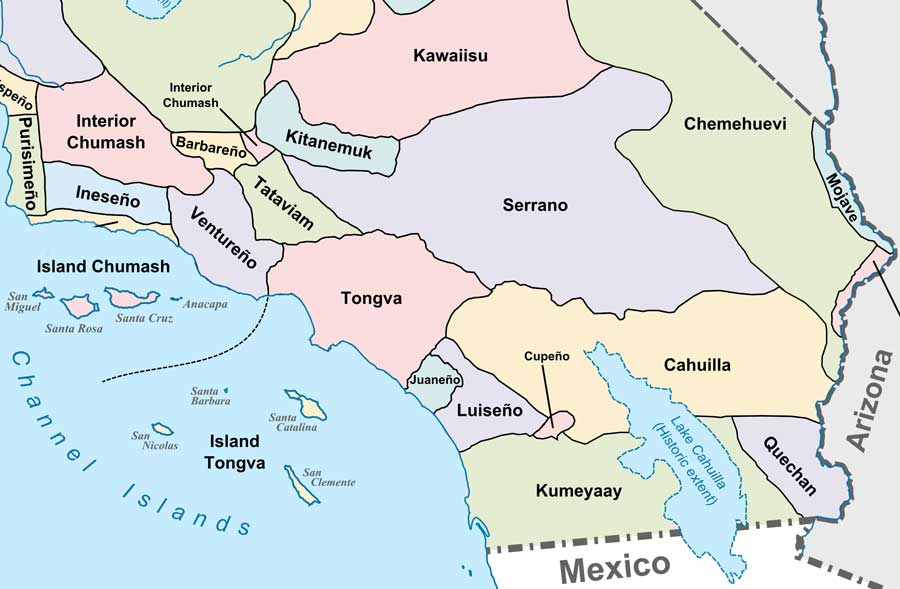
photo credit: Concerto, CC BY-SA 3.0
Map of southern California showing the range of local Native American groups.
Kumeyaay
The Kumeyaay lived in and around the area that is currently the greater San Diego region. This includes San Diego County up to Oceanside and east out to Imperial County and the Salton Sea. Their range also extended south into northern Baja. These people relied on plants to survive in the Sonoran Desert, the upper elevation Pine/Oak woodlands and the coastal chaparral and coastal sage scrub communities.
Cahuilla
The Cahuilla people lived in the very middle of southern California, around the Palm Springs and Coachella Valley area. This territory includes regions of Sonoran and Mojave Desert. Because the Cahuilla lived inland, they didn’t interact much with European settlers in the 17th century, as most of the early Spanish missionaries, soldiers and citizens colonized the coastal areas of California. During the 1840s, the Cahuilla engagement with anglo-settlers began to increase.
Chemehuevi of the southern Paiute
The Chemehuevi are a nomadic Native American group that lived along the eastern Mojave Desert region and in the Great Basin. This region included area near Death Valley and Las Vegas. They are the most southern branch of the Paiute people.
Tongva
Tongva people once occupied Los Angeles Basin as well as the Southern Channel Islands, including Catalina Island, San Clemente Santa Barbara and San Nicolas Islands. As a strong, hunter-gatherer community, the Tongva were among the most populous of the southern California native groups.
Chumash
The area around Santa Barbara, including the Northern Channel Islands, was occupied by the Chumash people. This includes coastal regions of Ventura, San Luis Obispo and Morro Bay. The Chumash were a sea faring people. They pushed off the Santa Barbara shore to colonize the Northern Channel Islands: Santa Cruz, Santa Rosa and San Miguel. Anacapa Island was also visited, however, due to lack of a water supply, the Chumash never built permanent settlements on Anacapa.
Quechan
These Yuman speaking people descended from Native American peoples living in southeastern California and southern Arizona. The Quechan were skilled warriors and actively resisted Spanish colonization.
Luiseño
The Luiseño people (Payómkawichum) lived in modern day Orange County and Camp Pendleton. These ‘People of the West’ foraged along the coast in the area of southern LA and northern San Diego.
Seri
The Seri people (Comcaac) lived in the Mexican region of Sonoran Desert. This includes land near the Gulf of California. They were a semi-nomadic group with strong ties to the desert and the coast.
Tohono O’odham
Previously known as the Papago, the Tohono O’odham are a distinct tribe of Native Americans who mostly settled in the northwestern area of Mexico and the eastern part of Arizona. These people foraged for many desert plants, including the white tepary bean.
Akimel O’odham
The Akimel O’odham, previously known as Pima, lived in central and southern Arizona. They lived in an area that kept them close to the Tohono O’odham people. Akimel O’odham territory encompasses the Gila River.
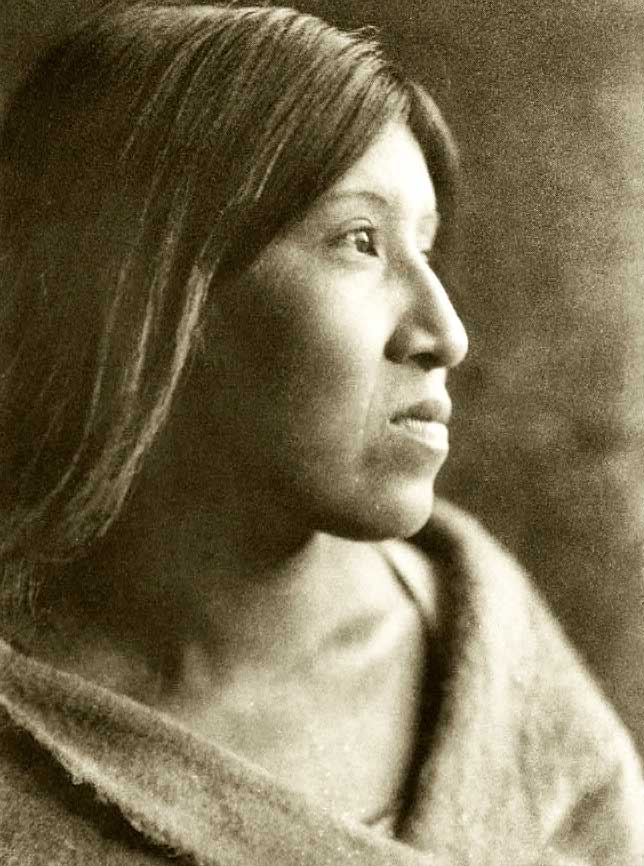
Young woman of the Cahuilla tribe in the Sonoran Desert of southern California.
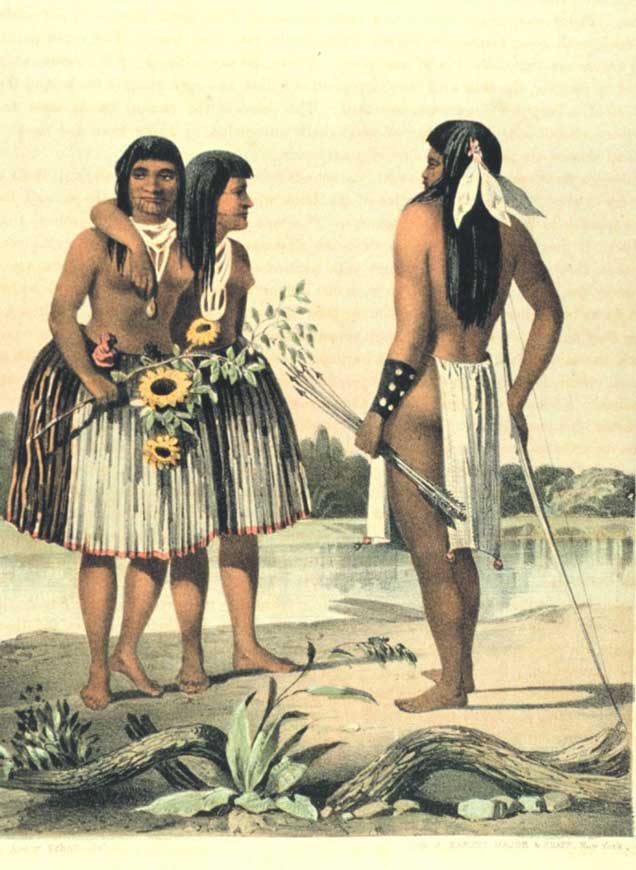
Quechan people foraging plants in southeastern California.
Plant communities of southern California
As these various Native American groups spread throughout southern California, they began to adapt their lifestyle and culture based on the availability of local plants in the region that they settled.
Each geographic area, whether its the Mojave or the Sonoran Desert, contains its own unique blend of available plants.
These plants became crucial resources for the tribes in that region. This is the basis of ethnobotany. People move into an area and make use of the native plants, and in doing so, their lifestyle and culture takes shape.
Below, we describe the different biomes, or geographic plant communities, which were available to early settlers in southern California. For the most part, these plant communities are still intact today.
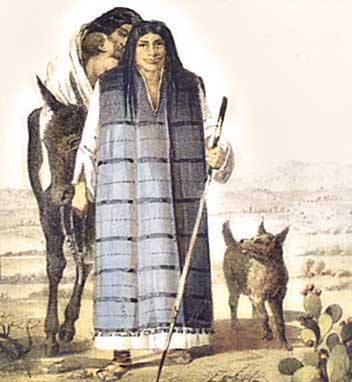
Kumeyaay family walks with dog and horse. An Opuntia cactus is seen on the right.
Engraving published by Schott, Sorony, and Co., 1857
Plant community map of southern California and the Channel Islands
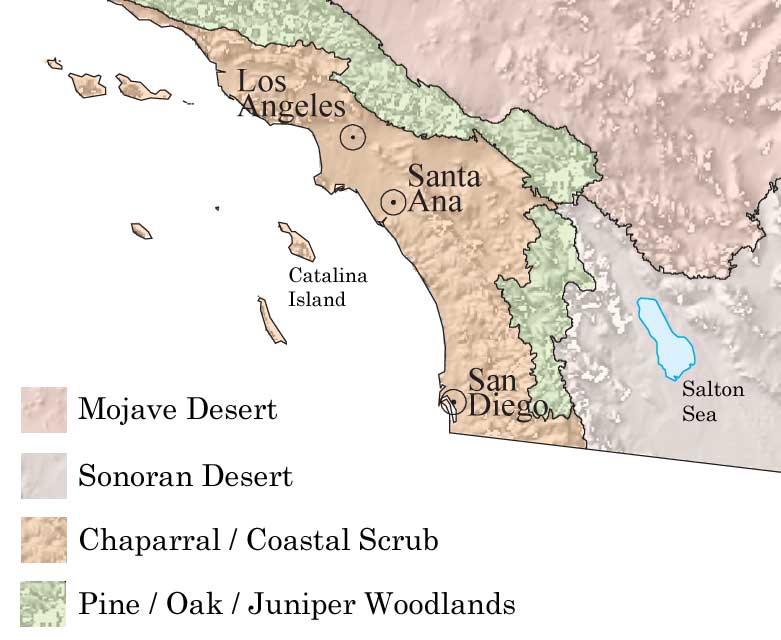
Coastal Scrub
As you might imagine, Native Americans in southern California took full advantage of their beautiful coastline. The Kumeyaay, Chumash, Tongva and Luiseno people all had settlements along the Pacific Ocean. The coast stays cool in the summer and offers close proximity to fishing and shellfish. In the summertime, this coast habitat was a nice change from the hot, dry interior region.
The plant community associated with this near-shore habitat is called coastal scrub. Coastal scrub plants tend to be soft-leaved and deciduous. The dominant plants here are the sage species and the sagebrush. Today, much of this biome has been greatly reduced due to urbanization and development. However, you can still see intact coastal scrub out at Point Cabrillo Monument in San Diego, CA.
Common coastal scrub plants include: coastal agave (Agave shawii), sage species (Salvia sp.), California sagebrush (Artemisia californica), laurel sumac (Malosma laurina), toyon (Heteromeles arbutifolia) and California buckwheat (Eriogonum fasciculatum).
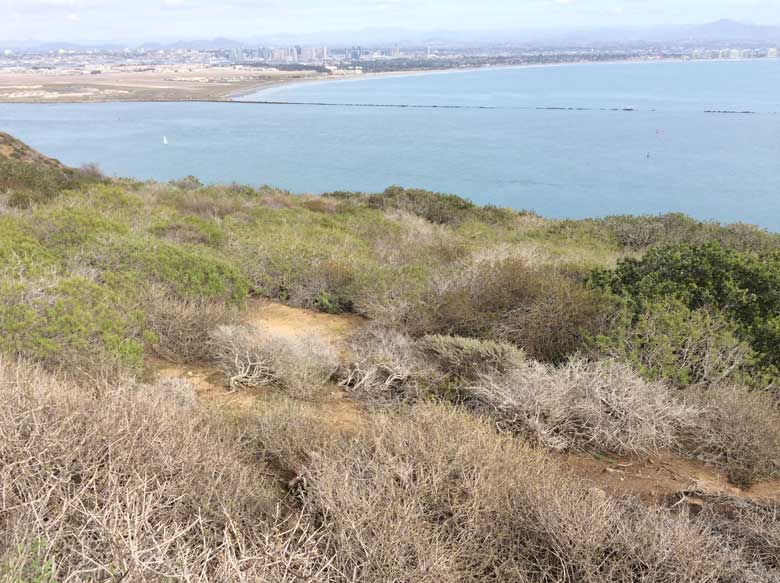
Coastal scrub canyon at Cabrillo Point
Chaparral
The chaparral is the shrubland biome between the coast and coast mountain range. This plant community is unique to southern California and Baja, Mexico.
The plants living here must be drought tolerant to deal with the hot, dry summers. The leaves of these plants tend to have a hard, waxy exterior to minimize evaporation.
Wildfires are common in the chaparral region, forcing these plants to adapt to this disturbance. Most chaparral plants can bounce back quickly after a fire.
The name ‘chaparral’ is derived from the Spanish word for scrub oak, ‘chaparro.’
Common chaparral plants include: mesquite (Prosopis sp.), chamise (Adenostoma fasciculatum), Our Lord’s Candle (Yucca whippleii), manzanita (Arctostaphylos sp.), oak (Quercus agrifolia), riparian cottonwood (Populus fremonti), willow (Salix spp.) and elderberry (Sambucus nigra).
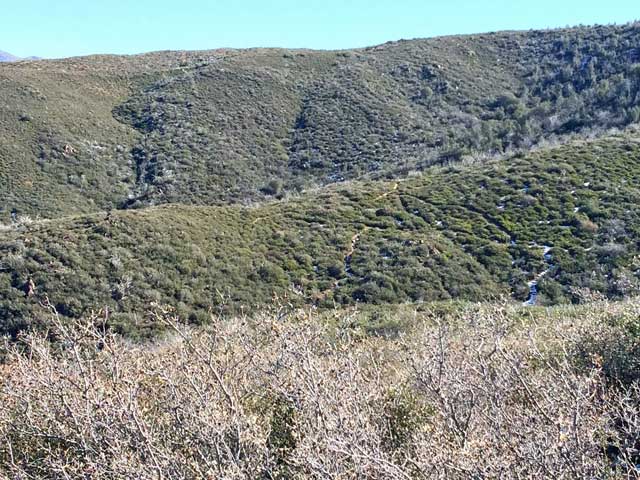
Chaparral plants in the foothills of the coast range.
Pine/Oak/Juniper woodlands
This plant community is found along the eastern slopes of the coastal mountain range, between 2,000 and 5,000 feet in elevation. Here, native tribes occupied forests filled with bushy, evergreen trees. The climate is defined as a hot arid steppe, however there is snow accumulation in the winter. If you drive from Julian towards Anza Borrego State Park, you’ll pass through a great example of this woodland biome.
In southern California, the Pine/Juniper woodlands have been decimated by wildfires. The Cedar Creek fires of 2003 were the most destructive. 270,000 acres of land was charred. These woodland fires encourage the encroachment of chaparral plant community. After the fires, plants in the chaparral biome tend to move in more aggressively than the slower growing evergreens.
Common plants include: California juniper (Juniperus californica), Pinyon pine (Pinus monophylla), Yucca (Yucca sp.), California oak (Quercus sp.) and manzanita (Arctostaphylos).
Sonoran Desert
A portion of the Kumeyaay and Cahuilla population spent much of their time in a true desert, the Sonoran Desert. These people adapted to the extreme temperatures and lived comfortably among the cholla cactus and bighorn sheep. A rain shadow east of the coast range creates the Colorado Desert, this is the western section of the broader Sonoran Desert. Anza Borrego State Park, the Salton Sea area and most of Imperial County are all included in the southern California Sonoran Desert.
The climate here is unique. The daytime high temperatures are very hot and the nights almost never drop low enough to generate frost. There are two rainy seasons. However, these days annual rainfall in this region is highly variable. Furthermore, it should be noted that historians speculate that rain in this desert was more common during the time-frame when Native Americans dominated this region. If this is true, it would have certainly made foraging for plants much easier.
Common plants in the Sonoran Desert include: creosote bush (Larrea tridentata), ocotillo (Fouquieria splendens), California fan palm (Washingtonia filifera) and cholla (Opuntia).
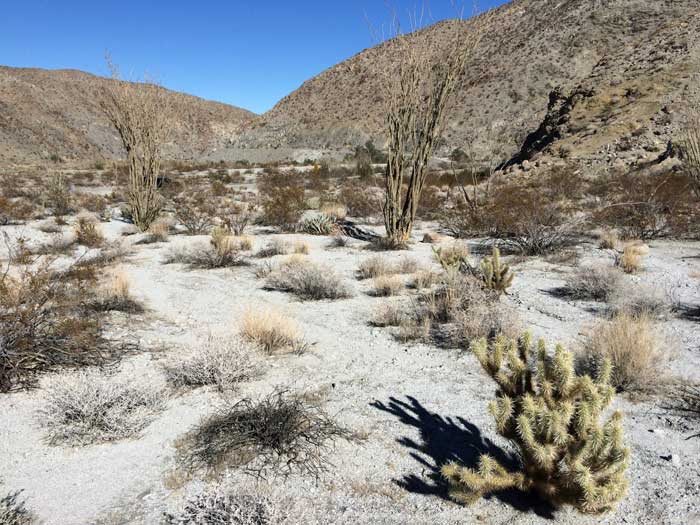
Cholla and ocotillo in the Sonoran Desert of Anza Borrego State Park.
Mojave Desert
The Mojave Desert is the smallest and driest of the North American deserts. This biome sits in the southeastern corner of California, overlapping with southern Nevada and southwestern Utah. Joshua Tree National Park and Death Valley National Park both lay within the Mojave Desert.
The iconic Joshua Tree (Yucca brevifolia) grows only in the Mojave. This is the tree famously featured on the legendary U2 album. The band drove out to Joshua Tree National Park for the album’s photo shoot.
In fact, the boundary of the Mojave Desert overlaps almost perfectly with the geographic range of the Joshua Tree. For this reason, Joshua Tree is considered an indicator species for the Mojave.
Geologically, the Mojave is mineral rich. The sparsely vegetated basin and range topography spill into flat, alluvial plain valleys. Much of the bedrock and deposit material is borax, potassium and other salts. This composition has led to an active mining industry in the region.
Apparently, a large lake once sat adjacent to the Mojave Desert. The Cahuilla people speak of Lake Cahuilla, a historic lake, that once filled Coachella Valley. This lake was fed by the Colorado River and helped make the area hospitable to settlement. At some point prior to the 1700s, the Colorado River changed course and Lake Cahuilla dried up.
Common plants in the Mojave Desert include: Joshua tree (Yucca brevifolia), Prickly pear (Opuntia sp.) and Cholla (Cylindropuntia sp.)
Speaking of the Mojave Desert, in the summer of 2018 I took a wonderful trip out to the Mojave National Preserve. I just wrote up this travel post about my weekend out in the preserve.
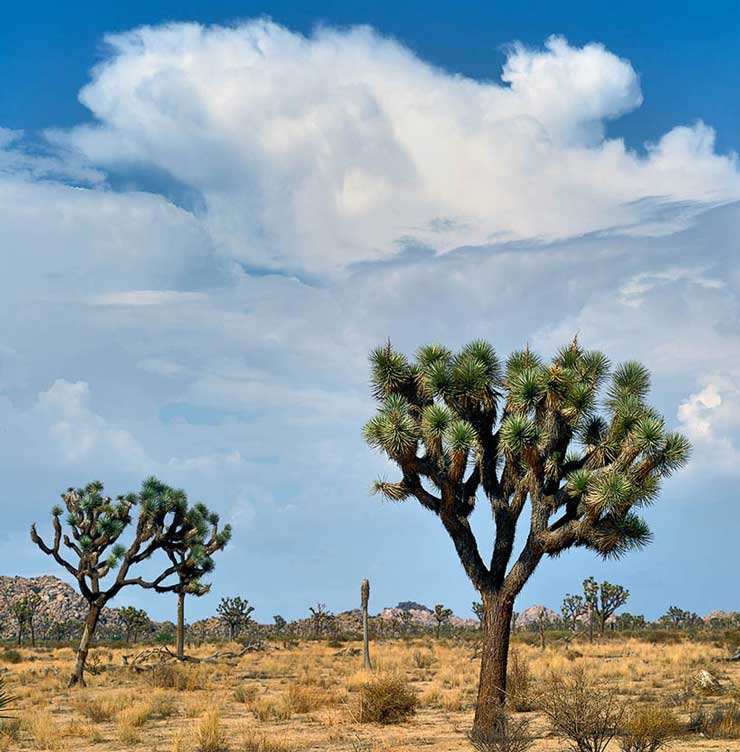
Joshua Tree is the defining plant of the Mojave Desert.
Thanks for stopping by and reading this article…
Check out more EthnoHerbalist articles on effective medicinal plants.
References and acknowledgments:
While compiling this resource on southern Californian ethnobotany, I’ve benefited from multiple resources and am grateful for all of them. I’ve included links and references on most of the individual plant pages. These point the reader towards various domains that house insightful ethnobotanical information. I’ve also benefited from interactions with botanists and inhabitants in and around Anza Borrego State Park, the town of Joshua Tree, the San Diego Botanic Garden, the Living Desert Museum in Palm Desert, University of San Diego, the University of Michigan and the In-Koh-Pah community. The Native American Ethnobotany Database does an excellent job of curating a vast amount of ethnobotanical information. Their searchable database has been an invaluable resource for this project.
Certain publications were especially valuable:
Bell, Willis H and Edward F. Castetter 1941 Ethnobiological Studies in the Southwest VII. The Utilization of of Yucca, Sotol and Beargrass by the Aborigines in the American Southwest. University of New Mexico Bulletin 5(5):1-74 (p. 18)
Bean, Lowell John and Katherine Siva Saubel 1972 Temalpakh (From the Earth); Cahuilla Indian Knowledge and Usage of Plants. Banning, CA. Malki Museum Press (p. 150)
Bocek, Barbara R. 1984 Ethnobotany of Costanoan Indians, California, Based on Collections by John P. Harrington. Economic Botany 38(2):240-255 (p. 6)
Castetter, Edward F. 1935 Ethnobiological Studies in the American Southwest I. Uncultivated Native Plants Used as Sources of Food. University of New Mexico Bulletin 4(1):1-44 (p. 10)
Hedges, Ken 1986 Santa Ysabel Ethnobotany. San Diego Museum of Man Ethnic Technology Notes, No. 20 (p. 45)
Romero, John Bruno 1954 The Botanical Lore of the California Indians. New York. Vantage Press, Inc. (p. 9)
Sparkman, Philip S. 1908 The Culture of the Luiseno Indians. University of California Publications in American Archaeology and Ethnology 8(4):187-234 (p. 195)
Warning: The information about plants on this website is intended for general educational purposes only. The author of this website accepts no responsibility for problems arising from the user’s misidentification, misuse, or use of plants. Please read the full TERMS associated with this website.

